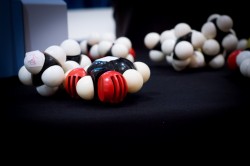Microscopic antennas to peer into nano-sized worlds
Vast arrays of antennas are being built to capture infrared (IR) light beams. You won’t find them in a desert though, pointed out towards space. Instead, these arrays are microscopic, capturing data at the nanometer scale and built on elemental landscapes of germanium, to power the next generation of molecular sensors for everything from biomedical diagnosis to environmental monitoring. For decades scientists have exploited the interactions between infrared light and molecules. When infrared light shines through a substance, the molecules vibrate with excitement from the absorbed energy. Each atom and the bonds connecting them wiggle at specific frequencies revealing their identity. This method, known as IR spectroscopy, works incredibly well but has limits. For IR spectroscopy to work, the infrared light must interact with the molecules of interest. But molecules exist on the nanometer scale, much smaller than infrared wavelengths. “There is a mismatch between the illuminated area and the size of the objects you want to look at,” explains Dr Paolo Biagioni, associate professor in the Department of Physics at the Politecnico di Milano, Italy. The solution is to focus the infrared light onto an area the same size as the smaller molecules. To do this, Biagioni and his collaborators in the EU project GEMINI use nanoantennas. Just like radio antennas that capture and focus radio waves, they concentrate infrared light onto a sample. By focusing the light beam to the nanometer level, “the interaction between the molecule and the infrared beam gets stronger,” says Biagioni. In this way, smaller amounts of molecules can be detected. These increases in the limits of detection have had a significant impact on biomedical sensing. Dr Hatice Altug, associate professor at Swiss Federal Institute of Technology in Lausanne, Switzerland, is optimistic about advancing IR spectroscopy to investigate proteins and related diseases. “One of the big advantages of infrared is looking at the conformational changes in the protein, which plays a very central role in diseases like Alzheimer's.” Many neurological conditions are determined by the shape of proteins, and Altug says that technologies are needed to look at these conformational changes in their native environment. This requires the ability to identify molecules in a complex mixture of biological fluids, for example, and is just one more area where IR technology is moving. Altug says another big push is “making this type of technology more accessible, low cost, compact and integrated,” bringing high-sensitivity IR spectroscopy to smaller field-based applications like environmental monitoring and airport security. Biagioni did not enter the GEMINI project, which is supported by the EU research line on Future and Emerging Technologies (FET) programme, with one specific use in mind. His main focus was to develop the fundamentals of germanium-based optical devices. Germanium is an excellent material for IR optics and, importantly, it is easily incorporated into existing silicon electronic devices and production processes. The researchers wanted to show for the first time that germanium can be successfully manufactured and used for IR nanoantennas. “We demonstrated a signal 100 times stronger than if the antenna was not there, and now our calculations show we may achieve a signal that is 1000 times stronger.” Read more: http://www.fetfx.eu/story/microscopic-antennas-peer-nano-sized-worlds/
Keywords
nanotechnology, infrared, molecular sensors, IR spectroscopy, nanoantennas, germanium
Countries
Switzerland, Italy



